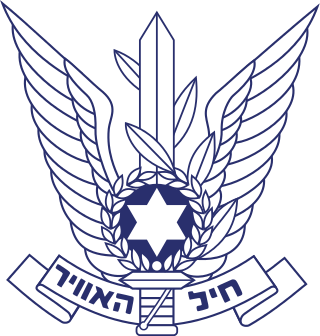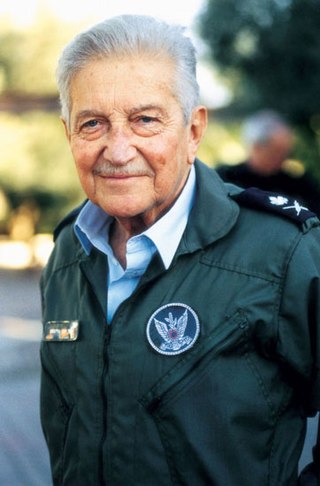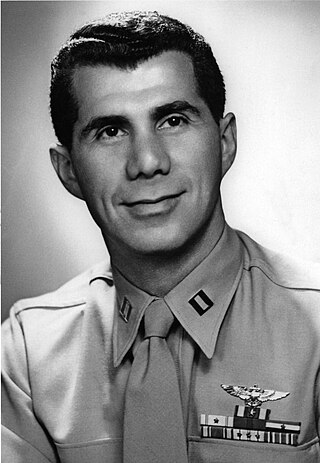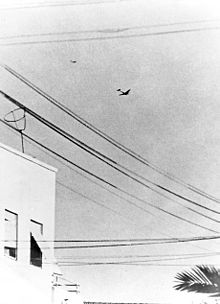
The Israeli Air Force operates as the aerial and space warfare branch of the Israel Defense Forces (IDF). It was founded on May 28, 1948, shortly after the Israeli Declaration of Independence. As of April 2022, Aluf Tomer Bar has been serving as the Air Force commander.

The Avia S-199 is a propeller-driven Messerschmitt Bf 109G-based fighter aircraft built after World War II using the Bf 109G airframe and a Junkers Jumo 211F engine in place of the original and unavailable Daimler-Benz DB 605 engine. It is notable as the first fighter obtained by the Israeli Air Force, and used during the 1948 Arab-Israeli War.

Ezer Weizman was an Israeli military general and politician who served as the seventh President of Israel, first elected in 1993 and re-elected in 1998. Before the presidency, Weizman was commander of the Israeli Air Force and Minister of Defense.

Hatzor Airbase, also titled Kanaf 4 is an Israeli Air Force (IAF) base, located in central Israel near kibbutz Hatzor Ashdod after which it is named. However, there have been no fighter jets stationed there since 2021, only patrol aircraft, UAVs and defense missiles. A Combined Operations Center for the US military and Israel has also been built there in 2021.

Ramat David Airbase is an Israeli Air Force (IAF) base located 20 km southeast of Haifa in the Northern District of Israel, close to kibbutz Ramat David in the Jezreel Valley. It is the northernmost IAF base in Israel with fighter jets, UAVs and helicopters based on it. There is an ongoing debate about whether Ramat David should be converted into an international airport.

Tel Nof Airbase, also known as Air Force Base 8, is the oldest and main base of the Israeli Air Force (IAF) located 5 km south of Rehovot, Israel. Tel Nof houses two strike fighter, two helicopter and a UAV squadron. Also located on the base are the Flight Test Center Manat and several special units of the Israel Defense Forces (IDF), among others Unit 669 and the Paratroopers Brigade training center and its headquarters.

The Sherut Avir was the air force of the Haganah and the forerunner of the Israeli Air Force.

101 Squadron of the Israeli Air Force (IAF), also known as the First Fighter Squadron, operates F-16C Fighting Falcon Barak out of Ramat David Airbase.

Aluf Dan Tolkowsky is a retired Israeli Air Force officer who served as a major general in the Israeli Air Force (IAF) from 1953 to 1958. A noted investor, he helped start the first Israeli venture capital fund.

Gordon Levett was a former Royal Air Force pilot in World War II who volunteered for a covert mission to fly supplies including dismantled fighter planes into the fledgling state of Israel in its 1948 Arab–Israeli War as part of Operation Balak. Later Levett joined the first squadron of the newly created Israeli Air Force, helping establish a permanent Israeli military and aiding in the founding of the state of Israel. Levett was the only English gentile pilot in the Israeli Air Force, where he rose to the rank of lieutenant colonel.
The Palavir, an acronym for Plugat HaAvir was the air force for the Palmach, based in Tel Aviv. Little is known about the Palmach's flying platoon due to its short life and its secrecy during the British Mandate. Like the rest of the Palmach it was made up entirely of Jewish fighters.

Pinchas ("Pini") Ben-Porat was one of Israel's first aviators. He was involved in the Palavir, Sherut Avir, the IAF's 101 Squadron, and EL AL.

Milton Rubenfeld was an American pilot who flew for the Royal Air Force and U.S. Army during World War II, later becoming one of the five founding pilots of the Israeli Air Force in the 1948 Arab–Israeli War. It is widely believed that Rubenfeld, the other four volunteer pilots, and the other machalniks changed the course of the 1948 Arab–Israeli War. He was injured and returned to the United States, and settled in New York state, where he married and owned a local business with his wife, Judy. Later, he moved his family to Sarasota, Florida, where he and his wife owned another successful business until he retired. He died in 2004. He was the father of actor/comedian Paul Reubens, who was known for creating and portraying the character Pee-wee Herman.

Operation Velvetta was a 1948 Israeli Air Force operation to ferry Supermarine Spitfires purchased in Czechoslovakia to Israel.

The Galilee Squadron was an aerial unit established by the Yeshuv during the 1948 Arab-Israeli War to assist the Jewish war effort in northern Palestine. Initially a part of the Sherut Avir, the aerial arm of the Haganah, it was absorbed into the fledgling Israeli Air Force (IAF) upon the latter's formation on 28 May 1948. The unit served throughout the war, following which it was amalgamated with several other units to form the IAF's 100 Squadron.

The History of the Israel Air Force begins in May 1948, shortly after the formation of the State of Israel. Following Israel's declaration of independence on May 14, its pre-state national institutions transformed into the agencies of a state, and on May 26, 1948, the Israeli Air Force was formed. Beginning with a small collection of light aircraft, the force soon transformed into a comprehensive fighting force. It has since participated in several wars and numerous engagements, becoming what has been described as "The mightiest air force in the Middle East".

Mitchell Flint was an American lawyer and veteran aviator. He was a United States Navy fighter pilot during World War II, and later served as an American volunteer pilot in Israel's first fighter squadron during the 1948 Arab–Israeli War. Mitchell Flint was credited as one of the people who assisted in the creation of the Israeli Air Force.

Above and Beyond is a 2014 documentary film about Mahal, produced by Nancy Spielberg, the youngest sister of Steven Spielberg,, written by Sophie Sartain, and directed by Roberta Grossman.

Louis Lenart was a Hungarian-born American-Israeli fighter pilot. His exploits during the 1948 Arab-Israeli War were documented in the 2015 documentary film A Wing and a Prayer.
George Lichter was an American fighter pilot and one of the founders of the Israeli Air Force.























